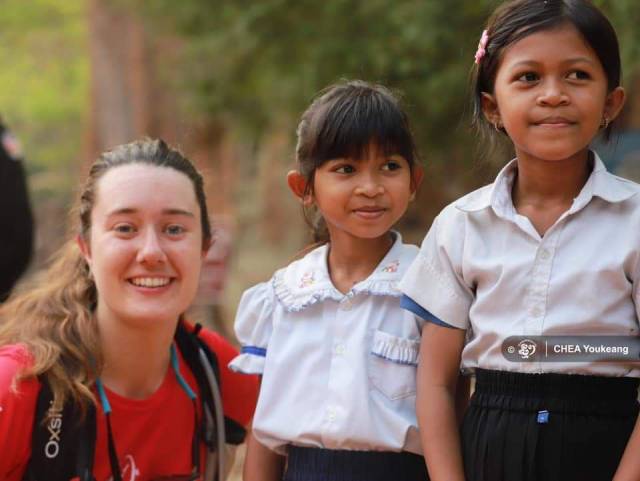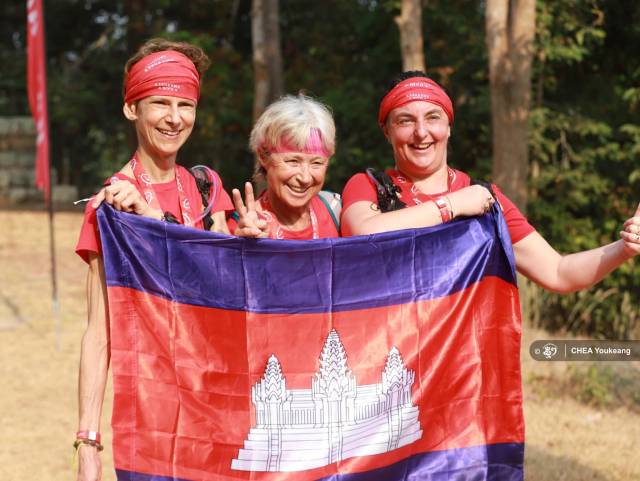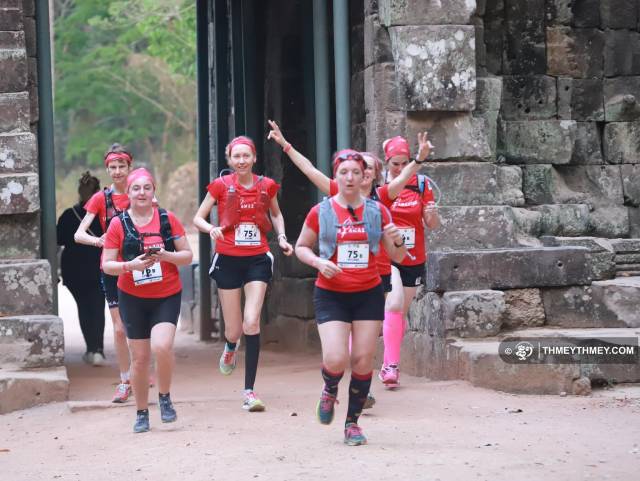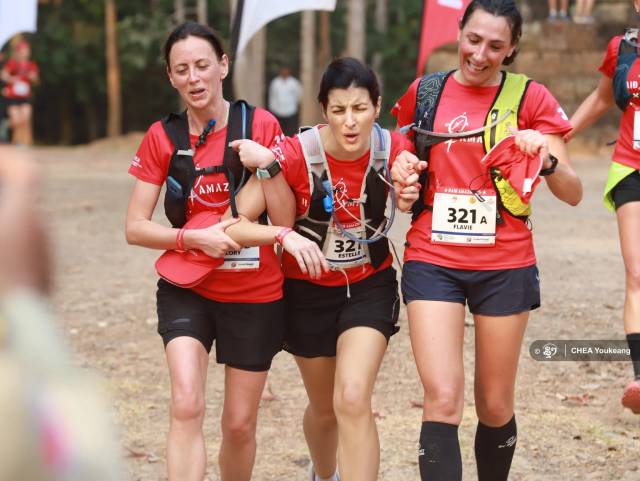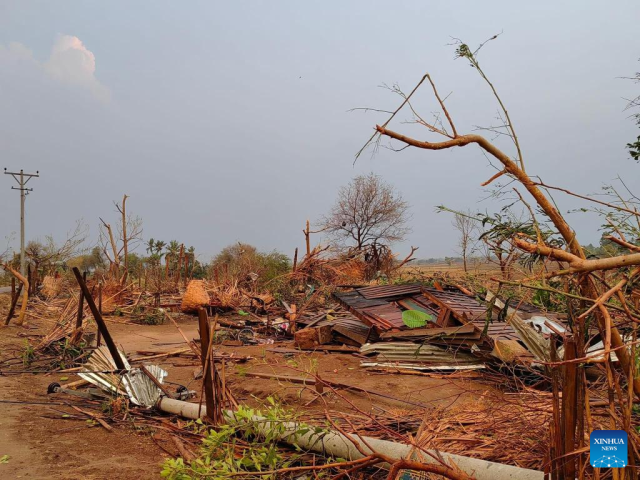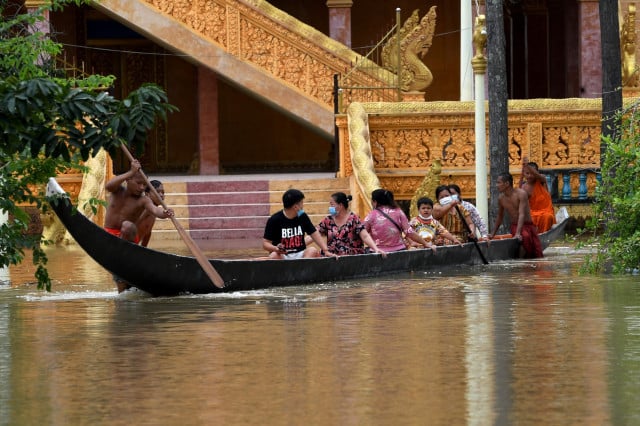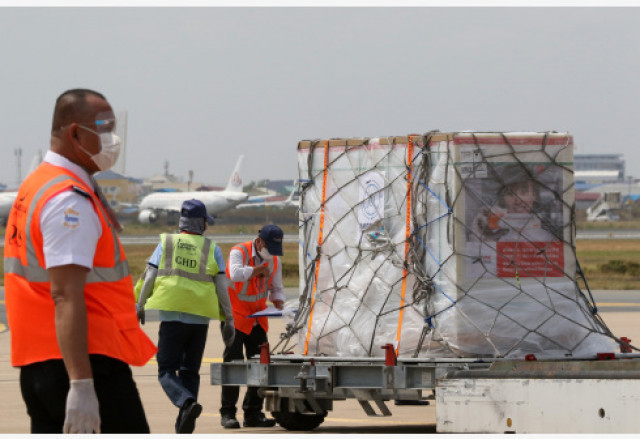Challenges, Tears, Joys, Warm Welcomes, Discoveries: Raid Amazones Ends

- By Teng Yalirozy
- March 22, 2024 11:55 AM
SIEM REAP — Getting up in the dark to be on the road by daybreak, and competing on foot, bicycles and in small boats while discovering villages and scenery that might not have been that different centuries ago: This was the routine of the 276 Western women who took part in the Raid Amazones in Siem Reap province.
From March 15 through 20, they raced in canoe-style boats, cycled on dirt roads in the countryside, and even had a treasure hunt among centuries-old temples in the Angkor Archeological Park. And they got welcomed by school children dancing in their honor as they zoomed by in Siem Reap city, exchanged hellos and smiles with women villagers on their way to the pagoda one early morning, and got cheered as they paddled in currents far less calm than expected.
The fourth Raid Amazones to take place in Cambodia since 2014 ended with a great deal of events and experiences for participants to remember. Launched in 2001 by Alexandre Debanne who is from France, it had also been held in the country in 2014, 2017 and 2018.
The Beginning
The event started on March 15 with a group of Western women gathering at 5:00 am when most people were still asleep in the country. Dressed in dark orange T-shirts and black shorts, they gathered cheerfully at the west gate of Ta Prohm, the temple in the Angkor Archeological Park being the starting point of the six-day sports and adventure events they were about to experience.
Since it was still night, the participants had to use flashlights to identify each other while the event organizers were busy setting up the scene to welcome the participants, and members of the media were waiting for sunrise to take photos and start covering the first day of activities. The Angkor Park authorities and guards were also on hand to facilitate matters for the event.
About 30 minutes passed; thousands of cicadas started ringing loudly as they normally do at sunrise, their sound mixing with the upbeat music that was being played to cheer the athletes waiting to go through the gate and into the jungle around the temple. The sounds of nature and music were what participants needed to fully wake up and get energized.
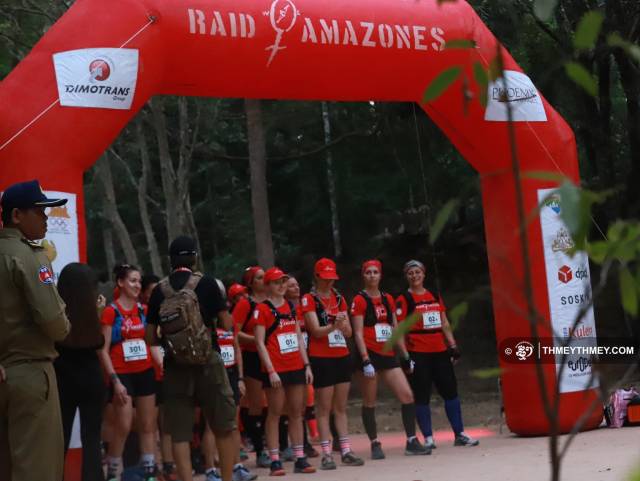 276 women who took part in the Raid Amazones gathered at the west gate of Ta Prohm Temple to start the first challenge. Photo: Chea Youkeang
276 women who took part in the Raid Amazones gathered at the west gate of Ta Prohm Temple to start the first challenge. Photo: Chea Youkeang
At around 6 a.m., as colors were starting to paint the sky at sunrise, the women in groups of seven or so were called in turn and, in no time, all disappeared into the jungle.
This first event consisted of running along a 15-kilometer trail among temples in Angkor Park: from Ta Prohm to Prasat Bei, and along Takeo, Ta Nei, Preah Khan, the temples of Angkor Thom as well as Victory Gate, the Gate of the Dead and Tonle Om Gate.
Christelle Illes, who was one of the participants from France, said that she had taken part in many marathons to prepare for this one she was doing with her two daughters. It had been her dream to be in this competition and being with her daughters made this even more special, she said.
“It's a moment for our family,” Illes said. “In France, we have our jobs and our children. But here, it's our moment.”
 Christelle Illes, who was one of the participants from France, gave an interview to Cambodianess before the competition. Photo: Chea Youkeang
Christelle Illes, who was one of the participants from France, gave an interview to Cambodianess before the competition. Photo: Chea Youkeang
On this first morning of the competition, groups of journalists and photographers waited outside for the participants to complete the circuit. Three hours later, the last participants reached the finish line and got ready for the next competition. Exhausted but in good spirits, the participants hopped on the busses to go to the cultural activities planned in the afternoon.
More Than Sports
Under a scorching sun, the participants were divided into groups of approximately 10 people. In addition to competitions, the program included activities to introduce them to the country’s culture and also the life of Cambodians in rural areas.
So on that first day, the women taking part in Raid Amazones distributed study materials to primary-school students in the countryside and learned how to grind rice grains and rid them of husk and bran. They also were served freshly-made traditional Khmer sticky noodles. All this meant to introduce those women from Australia, Belgium, France, North America, Switzerland, Turkey and the United Kingdom to the life of Cambodians in rural areas.
 One of the participants taught primary children before distributing the study materials. Photo: Chea Youkeang
One of the participants taught primary children before distributing the study materials. Photo: Chea Youkeang
As French-Cambodian participant Tea Kaliane explained, these visits made her aware of the patience and pride involved in cooking traditional dishes, and that Cambodians should explore the country's offerings, from the rice being harvested to the dishes created.
“The challenge is a big one,” she said. “It's not easy. But as long as we're in this together, and we can overcome the challenge together, that's what matters. That's what gives you the motivation and the energy and the power to keep going. And as a country, as Cambodian people, that's what we need.”
Under the evening sun over the yellowish rice field, the participants on that first day learned how people harvest rice, which some of them described as an unforgettable scene.
The women also got to try their hand at cooking Cambodian cuisine, at archery that is especially popular in Siem Reap province, explored unique handicrafts based on lotus flowers, and enjoyed lotus tea at a location next to paddy and lotus fields. They also visited the Jayavarman VII Hospital (Kantha Bopha III Hospital) for children in Siem Reap province.
 Under the evening sun over the yellowish rice field, the participants on that first day learned how people harvest rice, which some of them described as an unforgettable scene. Photo: Chea Youkeang
Under the evening sun over the yellowish rice field, the participants on that first day learned how people harvest rice, which some of them described as an unforgettable scene. Photo: Chea Youkeang
Challenges, Teamwork and Unique Memories
On March 16, the second day of Raid Amazones, the participants in their orange-and-black clothes travelled about one hour from Siem Reap city to a floating village of Kampong Khleang on the floodplains of the Tonle Sap lake, in the Kampong Khlaing commune of Soutr Nikum district in Siem Reap province.
Of course, the river! The next challenge consisted of navigating 15 kilometers on the river in canoe-type boats. About 100 yellow canoes had been laid ready on the shore. Shortly after 6 a.m., the women armed with oars ran to collect their canoes meant for two or three persons.
The yellow canoes with orange-shirt rowers created a never-seen scene on the wide river flowing through the 10-meter-high wooden stilts of the houses from which the residents watched the race. The course was not as smooth as expected and some canoes swirled while others moved forward fast.
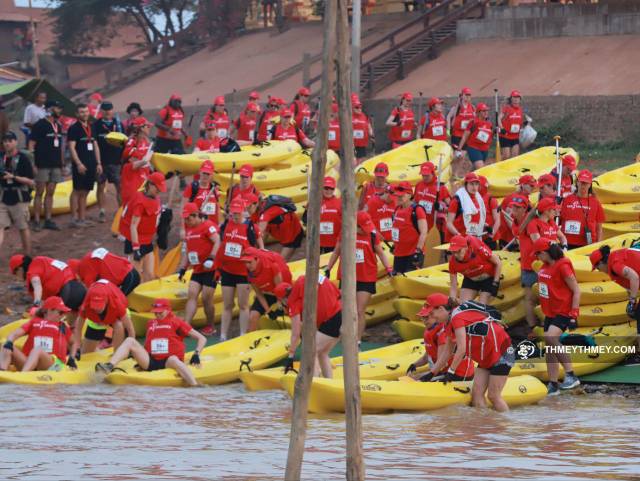 The participants were coming down the river with their canoes. Photo: Chea Youkeang
The participants were coming down the river with their canoes. Photo: Chea Youkeang
The rowers were welcomed by the local residents with people of all ages waving at them as they went by, which made the women forget their exhaustion.
About three hours later, canoes started to arrive, one at a time, to the starting line where students and people from the area were waiting to congratulate them. Some participants got back with a smile, others were crying. A few competitors collapsed from exhaustion and needed help to walk to shore.
However, their fatigue faded away when the music began. The Raid Amazones participants were soon dancing with the children.
A group of three rowers from France said they had gone canoeing countless times in France, but this time, the experience was unique because of the smiles and warm welcome of the residents along the river.
“It was really great to see the sunrise, and we saw lots of kids waving their hands and saying hello to us,” they said. They added that they had trained in France, which made it easier for them to do the canoe race in Cambodia.
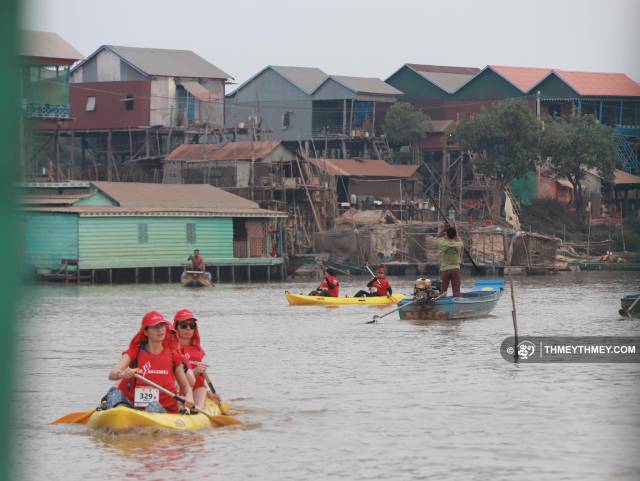 The rowers were welcomed by the local residents with people of all ages waving at them as they went by, which made the women forget their exhaustion. Photo: Chea Youkeang
The rowers were welcomed by the local residents with people of all ages waving at them as they went by, which made the women forget their exhaustion. Photo: Chea Youkeang
On March 17, the Raid Amazones participants competed in another challenge in the countryside. The event was a 21.5-kilometer bicycle race and ran near National Road 6 near the former Siem Reap International Airport to the Phnom Krom Pagoda, along a narrow countryside dirt road.
The participants were in teams of two with one woman on a bicycle and the other running. They went along people’s houses, beautiful rice fields, the temples at Phnom Krom mountain, and got the opportunity to observe the daily life of the people in those areas.
At one point, they came across senior village women going in the opposite direction, dressed in white blouses and traditional skirts, and riding plain bicycles on their way to the pagoda, as if two worlds were meeting having bicycles in common.
This was a special moment, and the Western women and the Cambodian women smiled at each other.
 At one point, they came across senior village women going in the opposite direction, dressed in white blouses and traditional skirts, and riding plain bicycles on their way to the pagoda, as if two worlds were meeting having bicycles in common. Photo: Chea Youkeang
At one point, they came across senior village women going in the opposite direction, dressed in white blouses and traditional skirts, and riding plain bicycles on their way to the pagoda, as if two worlds were meeting having bicycles in common. Photo: Chea Youkeang
The race was demanding, said Stephanie and Mélanie, two competitors from France. Though they had to run and bike under the scorching sun, which was especially draining since they were not used to the tropical climate of Cambodia, they said it was worthwhile since they learned about people’s lifestyles.
Take a Break and Hunt for Treasures!
After three days of intense physical activities, the participants assembled in Angkor Park. They were wearing skirts made of long pieces of orangey fabric knotted at the waist and covering their legs out of respect for the Cambodians’ ancestors who built the temples during the Angkorian Empire.
As they visited the walled city of Angkor Thom, the Terrace of the Elephants, the temple of Angkor Wat and the Bayon, the participants had to answer questions on Cambodia’s culture and history. This was an opportunity for them to visit the famed UNESCO World Heritage site, and learn about the country’s history, architecture, and also its Buddhist tradition.
Participants were divided in teams of around eight people who visited the temples at their own pace, having with them a book on Cambodia to help them find the answers. They also were allowed to ask tour guides for help.
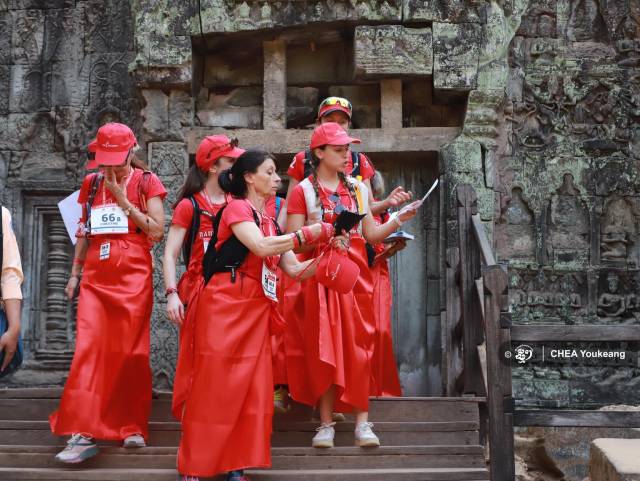 The participants answered questions on Cambodia’s culture and history. Photo_ Chea Youkeang
The participants answered questions on Cambodia’s culture and history. Photo_ Chea Youkeang
The Last Two Days with Victory and Tears
Heat and dust marked the fifth day of the challenge, during which participants took part in a 38-kilometer mountain bike race from the Teuk Chob Khnar Po Community Forest to the 11th-century temple of Chau Srei Vibol.
A traditional blessing-ceremony dance was performed by elementary school students to greet them at the finish line. Some of the women kneeled or sat on the ground to get at the children’s level to better watch their performance or talk with them.
Then the last day arrived, the Raid Amazones ending on March 20 with a 10-kilometer run in and around Angkor Thom. The women started at the Bayon temple and sprinted southward along the Angkor Thom walls toward the Bei temple.
Upon arriving at the finish line, most, if not all, of them burst into tears but of joy for the sleepless nights, the pedaling and running across villages, and the rowing across a Tonle Sap Lake tributary. Some of them collapsed, having gone through six days of intense activity. Many hugged each other, all of them having a smile of victory.
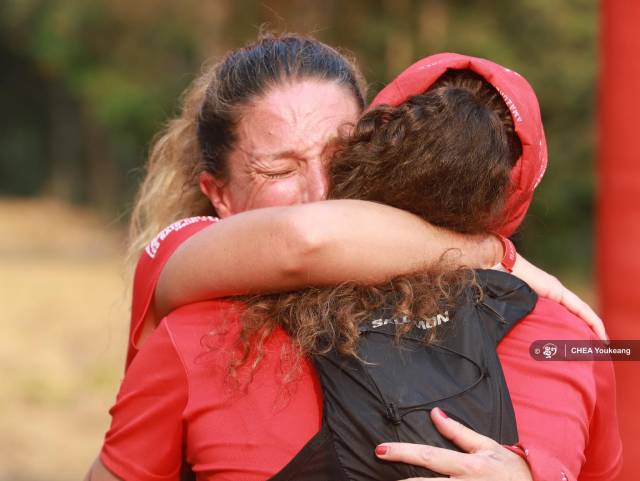 The participants cries and hugged each other upon reaching the finished line of the last day's challenge. Photo_ Chea Youkeang
The participants cries and hugged each other upon reaching the finished line of the last day's challenge. Photo_ Chea Youkeang
All the women received a medal for completing the competition, some of them too touched to speak, having gone through a once-in-a-lifetime experience, having competed in a demanding sport event against Western women in a Southeast Asian country.
Patricia Rossetti, who was one of the participants, said that she had been lucky to meet Cambodians in Siem Reap province during the event. She added that she was planning to visit other parts of the country before going home.
Southeast Asian Countries and Tropical Weather: Preferred by Europeans
From October or so and until April if not May, countries in Europe experience freezing temperatures, making this the best time to hold the Raid Amzones in tropical-climate countries with rich cultures such as Cambodia in order to attract European participants, said Alexandre Debanne of Raid Amzones.
“We love Asia; it's so special,” he said. “It's the part of the world that the Europeans prefer for traveling because of the nature and culture, and Buddhism…a quiet religion.”
 Alexandre Debanne gave an interview to Thmey Thmey Digital Media.
Alexandre Debanne gave an interview to Thmey Thmey Digital Media.
According to Debanne, Europeans constantly complain about their hectic lives, thus coming to Cambodia and other countries in the region is an opportunity for them to learn about life in some rural areas where children always have a smile on. Events such as Raid Amazones can help them accept and appreciate the world they live in, leaving them with a positive attitude that can lead to a more harmonious world, he said.
According to the program of the competition, which took place in Cambodia for the fourth time, the six-day event enables participants grouped in teams of two or three members to strengthen their team spirit, solidarity, and community sharing, and take part in activities that contribute to benefitting the environment, natural resources, as well as people of the region.
In addition to helping promote Cambodia’s culture and history, and the country as a destination in tourism, Raid Amazones also contributed to charitable activities such as the French association A Chacun Son Everest that brings support to children, teenagers and women battling cancer.
During the days of the event, the women participants went through excitement and exhaustion, laughter and occasionally tears, plus great moments of teamwork, making this event a very special one they will not soon forget. Plus, they explored the dense jungle at a 1,000-year-old city among the smiling local people.
Who would not want to experience such things?!?
